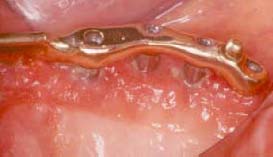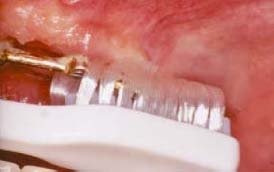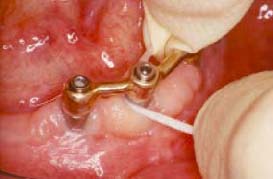16
Follow Up and Maintenance of the Implant Overdenture
Success of implant-supported overdentures is related both to a correct biomechanical design and maintaining a healthy oral environment. The focus in implant dentistry, all too often, is successful placement of the implant, establishing osseointegration, and building the restoration. The real driving force must be to maintain a steady state of bone around the implant for the patient’s lifetime. This success will only be achieved by proper biomechanics and healthy gingival tissues with adequate dimensions and contours that will allow for ideal maintenance.
CHARACTERISTICS OF IDEAL PERI-IMPLANT TISSUES
- Pink
- Firm/adherent
- Keratinized tissue circumferentially around the implant
The forces generated by the overdentures in function and the constant accumulation of plaque place the success of the overdenture at risk. The nature of the soft tissue surrounding the implant component as it enters the oral cavity can influence the patient’s ability to control plaque. Non-keratinized peri-implant tissues can be easily traumatized and therefore uncomfortable for the patient to perform oral hygiene. Also the shape of the soft tissue, which can be a result of the underlying residual ridge, can interfere with the proper plaque control. The tissue contours as well as the attachment assembly design must allow for easy and thorough maintenance.
CONSEQUENCES FOR FAILURE TO ACHIEVE CLEANSABLE ATTACHMENT DESIGN
- Peri-Implant Mucocitis: Inflammation limited to soft tissue
- Peri-Implantitis: Resorption of the bone around the implant (Figure 16.1)

- Recession: Exposure of the implant surface
- Tissue Overgrowth
- Calculus Formation and Retention
All attachment assemblies in the oral environment provide surfaces for bacterial growth. The plaque biofilm in proximity to the peri-implant soft tissue can result in the following peri-implant diseases:
- Peri-Implant Mucositis: Inflammation limited to the soft tissue
- Peri-Implantitis: Bone resorption around the implant
Both the patient and the clinician have a defined responsibility to care for the implant-soft tissue interface of the attachment assembly. Effective daily plaque removal prevents not only the initiation of peri-implant disease, but also the development of calculus, which can interfere with the function of the attachment assembly components.
The clinician contributes to the preventive regimen by discriminating between the presence of health and disease and by evaluating the status of the attachment assembly. The soft tissue, through which the implants enter the oral cavity, and the mucosal surfaces covered by the overdenture should be evaluated for evidence of inflammation. In addition, the examination should include palpation of the peri-implant tissues to detect bleeding or suppuration.
HOME CARE IMPLEMENTS
There are many plaque-control implements from which to choose. Those recommended should be simple and effective for the patient to use. Often patients who require implant-supported overdentures have limited anatomical access due to the extent of previous alveolar ridge resorption as well as the structural complexity of attachment assembly.
Toothbrushes
Toothbrushes should be selected based on the type of attachment assembly and the limited access to the surface intended to be cleaned.
END-TUFTED TOOTHBRUSHES End-tufted toothbrushes may be used where the oral anatomy may limit the use of a full-headed toothbrush. These are ideal for site-specific plaque removal around stud attachments.
ACCESS BRUSH The Access brush (Imtec Implant Company) is designed to clean the buccal and lingual surfaces of the abutment and the bar simultaneously (Figure 16.2).

INTERDENTAL BRUSHES Interdental brushes can be used on the proximal aspect of abutments that support the bar, provided that sufficient clearance exists between the abutment, bar, and soft tissue. All interdental brushes should have a nylon or plastic coating over the center wire so the abutment is not deformed or scratched in the cleaning process.
PROXY TIP Proxy Tip (Advanced Implant Technologies) is an all-plastic type of interdental brush that can be used as an alternative.
Flossing Cords
Floss can be used circumferentially around the abutment to clean the peri-implant crevice.
THORNTON BRIDGE AND IMPLANT CLEANER Thornton bridge and implant cleaner is a floss with stiff threaders on both ends with a yarn-like portion in the middle. It can be an effective cleaning approach for the bar attachment assemblies. The threader allows the patient to thread the floss around the abutments and bar (Figure 16.3).

POSTCARE Postcare (Sunstar Butler) is a nylon-woven flossing cord that is abrasive enough to remove calculus. It has a pre-formed end similar to a hook, enabling the patient to t/>
Stay updated, free dental videos. Join our Telegram channel

VIDEdental - Online dental courses


